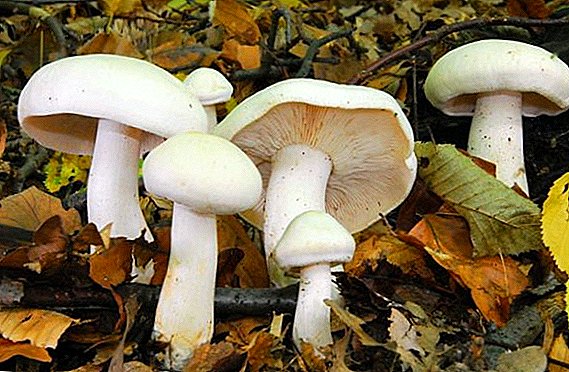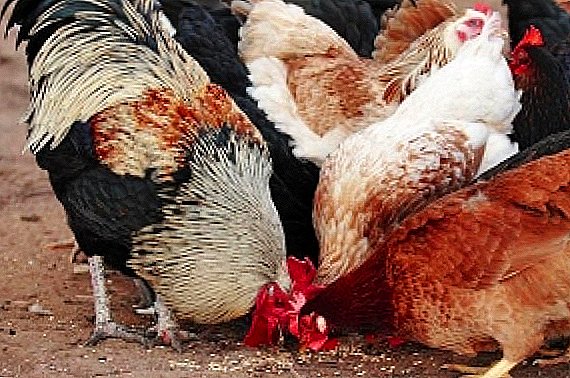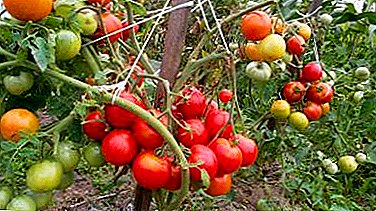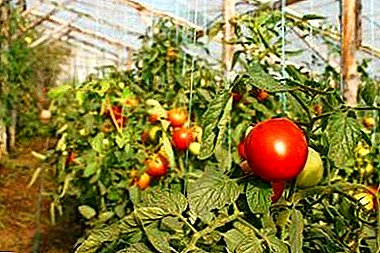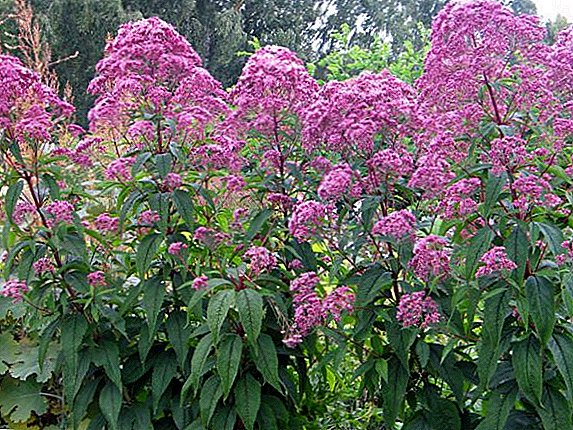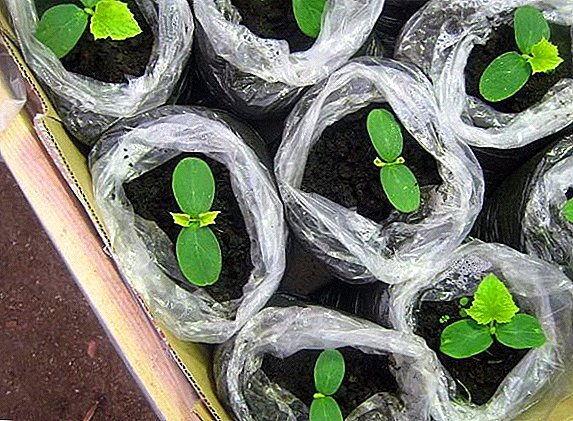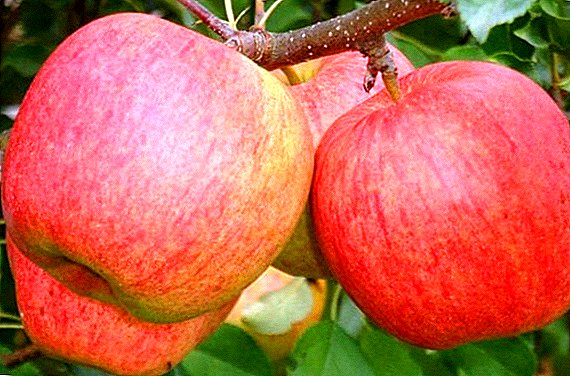 Apple champion varieties due to its product and taste characteristics won a truly champion fame among European gardeners. This variety is considered by many to be an ideal option for commercial production. In addition, it very successfully combines the simplicity of cultivation conditions and high yields. How to grow a variety in your own area, the subtleties of planting and care, the secrets of professionals regarding pruning and pest control - we will describe all this further.
Apple champion varieties due to its product and taste characteristics won a truly champion fame among European gardeners. This variety is considered by many to be an ideal option for commercial production. In addition, it very successfully combines the simplicity of cultivation conditions and high yields. How to grow a variety in your own area, the subtleties of planting and care, the secrets of professionals regarding pruning and pest control - we will describe all this further.
Inference history
"Champion" was produced in 1970 by Czech botanists at the Experimental Station in Golovousy. At the heart of the variety is the genetic set of parents — Golden Delicious and Rennet Orange Cox. European consumers of the apple market praised the quality of the new hybrid, and soon it became desirable not only in the Czech Republic and Poland, but throughout Europe.
Bright appetizing color of fruits attracted buyers, causing irresistible interest, and the taste captivated forever. It really was a triumph of breeders. Their work adequately competed in all respects with other varieties.
Did you know? In the world, the leader in apple production is China, the second place was taken by the United States of America. In Europe, the championship went to Poland.Repeat the success of Czech scientists tried many times Polish gardeners and agronomists. As a result of their stubborn efforts, clones were produced: apple trees "Champion Arno" and "Renault Champion" (1992), the differences which we dwell below.
Ukrainian gardeners also started cultivating the variety: for the first time, a variety was tested in the steppe zone. According to experts, the Champion apple tree has prospects in the Carpathian region, in the west in the steppe and forest-steppe zones, where it grows in climatic conditions close to its relatives.
Features grade
The main secret of the success of the apple "Champion" in high-yielding and precociousness, as described in the agrotechnical descriptions of the variety, as well as photos and reviews of gardeners. Consumers like fruiting stability, compact trees and ease of maintenance.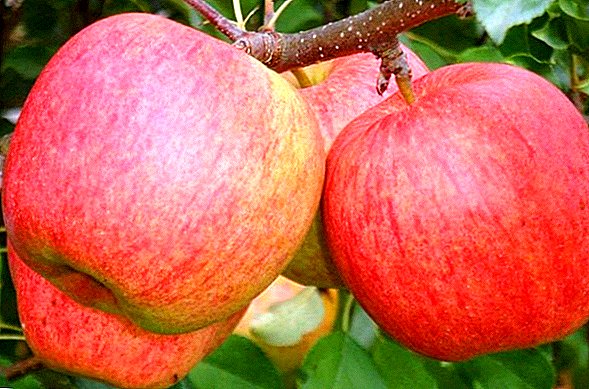 The first harvest can be obtained already from a three-year sapling. In addition, the taste and visual appeal of large fruits, which can be stored in the cellar for six months, evoke delight. Trees do not require additional conditions for cultivation, are resistant to scab and powdery mildew.
The first harvest can be obtained already from a three-year sapling. In addition, the taste and visual appeal of large fruits, which can be stored in the cellar for six months, evoke delight. Trees do not require additional conditions for cultivation, are resistant to scab and powdery mildew.
Important! Apples are not recommended to be stored in the same compartment with other vegetables and fruits. The fact is that they release a gaseous substance - ethylene, which activates the ripening process of all fruits: potatoes and carrots start sprouting and frowning, and apples lose elasticity.Perhaps the variety could be considered perfect if it were not for its weakness in front of pathogens of bacterial burn and bitter pitting. This is the only nuance that breeders did not take into account. But with proper adherence to agricultural technology and timely preventive measures, this drawback does not pose a threat to the future harvest and your garden.
Tree description
Apple trees "Champion" are characterized by short stature, compact oval crown, as shown in the photo, and a low thickening of the branches, which is typical for descriptions of dwarf varieties. Shoots actively develop before the plant enters the fruiting phase, then growth slows down a lot.
Check out the best varieties of apple trees for growing in different regions: the Urals, Siberia, the Moscow region, the North-West.
 The trunk is not thick, covered with gray thin bark. Skeletal branches are moderately developed, directed upwards, depart at an angle of 50 degrees. Apple tree requires some knowledge when pruning, because new growth appears very passive. Therefore, illiterate haircut is fraught with loss of fruit. The buds on the tree are very sensitive to changes in temperature. At the first warm sunny days they are ready to develop.
The trunk is not thick, covered with gray thin bark. Skeletal branches are moderately developed, directed upwards, depart at an angle of 50 degrees. Apple tree requires some knowledge when pruning, because new growth appears very passive. Therefore, illiterate haircut is fraught with loss of fruit. The buds on the tree are very sensitive to changes in temperature. At the first warm sunny days they are ready to develop.
Inflorescences are formed together. Buds open in May. Pollen has long-term viability. Without the intervention of neighboring pollinators, the tree can self-pollinate, forming up to 30% of the fruit. Zelenushki are tied on all branches and even on the trunk.
Did you know? On planet Earth, every other fruit tree is an apple tree. General planting of this fruit crop, according to scientists, occupies 5 million hectares.
The clone "Champion Renault" differs from the parent apple with medium resistance to winter conditions and powdery mildew; otherwise, their description is identical. Its fruits are brighter and sweeter, they far exceed the source code in taste and appearance. Gather them in September, and begin to use only after a month.  As a stock for grafting "Champion Arno" served 54-118. Such samples take root in a short time and vegetate quickly. Adult seedlings reach a three-meter height. They develop a powerful root system, which does not give excess seedlings, ensures reliability and endurance to strong winds. Such apple trees do not need to be tied to pegs.
As a stock for grafting "Champion Arno" served 54-118. Such samples take root in a short time and vegetate quickly. Adult seedlings reach a three-meter height. They develop a powerful root system, which does not give excess seedlings, ensures reliability and endurance to strong winds. Such apple trees do not need to be tied to pegs. 
Fruit Description
The fruits of "Champion" and its clones are very appetizing in appearance.
Firstly, their size is of interest: on average, one apple weighs from 150 to 200 g. All of them are of the correct round shape.
Did you know? If you pick seeds from one apple tree and plant a hundred seedlings, they will grow completely different.Secondly, the red vague blush on a thin skin with a white speck lures. During the ripening of apples for harvest, it is barely visible on the green-yellow surface, and when the apples lie for a while, they are completely covered with orange-purple color. "Champion Arno" is distinguished by a bright surface color, which in the bud variant occupies almost the entire surface. The apples of the clone Renault Champion are outwardly redder and sweeter.
Thirdly, the sourish-sweet taste of apples makes a special impression on consumers. According to the tasting characteristics, the variety was awarded 4.7 points out of 5 possible. Their flesh is a delicate cream color, medium dense, juicy and fragrant.
Yield
 Apple "Champion" are distinguished by stable and generous fruiting: for minimal attention, the variety will thank the gardener for large and high-quality fruits. In addition, it is not necessary to wait for decades until the tree enters the period of fruit set. Apple greens begin to form in 2-3 years of life, and already five-year saplings each year give 20 kilograms of harvest each.
Apple "Champion" are distinguished by stable and generous fruiting: for minimal attention, the variety will thank the gardener for large and high-quality fruits. In addition, it is not necessary to wait for decades until the tree enters the period of fruit set. Apple greens begin to form in 2-3 years of life, and already five-year saplings each year give 20 kilograms of harvest each.
Winter hardiness
Mature trees "Champion" winter well, but young specimens need additional shelter. According to experts, the variety has average winter hardiness. In a harsh cold climate, it is extremely difficult to grow such a species. Its representatives can easily tolerate short-term frosts up to 15-18 ° C. And young seedlings cover branches and mulch pristvolny circles even with small frosts.
Important! Under apple as a mulch it is undesirable to use coniferous sawdust and other materials that contribute to the oxidation of the soil. When mulching pristvolny circles, retreat from the tree 10 cm, so that during the decomposition of the poured layer of pathogenic bacteria and fungal spores do not infect the trunk.
The best pollinators
Apple "Champion" are prone to partial self-pollination. But in this case, the percentage of formation of the ovary will be low. Experts recommend raising fruiting in a successful neighborhood with varieties: “Idared”, “Teremok”, “Lobo”, “James Grieve”, “Florina”, “Priam”. In the garden they are advised to place in close proximity. 
Using
The fruits of this variety are very tasty fresh. They are suitable for long-term transportation, well preserved in storage. Most often they are grown for such purposes. Also, apples can be used for the preparation of homemade canned and juice.
Selection of seedlings: recommendations
Strong healthy planting material - the key to successful development of apple in the first ten years. Therefore, when buying a seedling, it is important to carefully inspect all its parts, check the freshness of the roots and wood.
Important! For successful long-term transportation of purchased seedlings, roots are wrapped with a damp cloth and placed in a plastic bag. The branches are slightly tied to the trunk. If the planting is not planned immediately after purchase, the tree should be placed in the root of the package with a wet ground.Experienced gardeners recommend:
- Make a purchase in specialized garden centers and nurseries.
- Investigate the root system. Its processes must be powerful and healthy without any influxes, dark spots, rot, mold or other mechanical damage. Also pay attention to the general condition of the roots. Make sure they are not dry. To do this, make a small scratch on any edge. Revealed fresh wood indicates the quality of the seedling.
- Examine the state of the trunk and the place of its transition to the root. Outwardly, the ideal seedling reaches a half-meter height. Too high instances of poorly take root and only at first glance seem to be a very profitable offer. In fact, they sit for a long time without growth and are rootedly experiencing rooting.
- Count the skeletal branches. There should be about five of them on the right apple tree.
- If the purchase is made in the autumn season, all the leaves on the seedlings are removed, and the roots, regardless of the time of purchase, are treated with a clay mash so that they do not dry out.
Landing tips
Some beginners of garden and garden affairs are sure that for good fruiting it is enough to make the right choice of apple varieties and acquire a healthy seedling. At the same time, they assign a very small role to the landing process, considering that it is only necessary to act according to the classical scheme. Using the experience of those who, in their own experience, verified the fallacy of such beliefs, consider the main nuances of rooting apple seedlings.
Optimal timing
In our latitudes, it is common for planting fruit crops to be planted in spring and autumn, when it is warm enough outside, but the sun's rays are not as aggressive as in summer. If you rooted the apple tree in the spring, by the winter it will develop strong roots, the trunk will get stronger, and it will be adapted to low temperatures. In this case, it is advisable to land in the last weeks of April, when the earth is already well warmed up, and spring frosts are bypassed.
Did you know? The fourth part of apples is air, that is why they never drown in water.
The only drawback of this period is the need to constantly moisten the tree. Before planting, the roots are left for a day in a container with water so that they are saturated with moisture, and in the process of rooting until the autumn, they are watered regularly so that the apple tree does not dry out and survive the winter well.  In the case of autumn planting, the tree will have time to gain a firm foothold in the ground and the root processes will grow to the cold. After winter, these seedlings grow quickly. The main thing - to have time to plant them a few weeks before the onset of cold weather. Such samples do not need to be watered, because the weather conditions contribute to dampness and coolness, which is important for young not yet rooted seedlings. The optimal period of their landing is the first two decades of October.
In the case of autumn planting, the tree will have time to gain a firm foothold in the ground and the root processes will grow to the cold. After winter, these seedlings grow quickly. The main thing - to have time to plant them a few weeks before the onset of cold weather. Such samples do not need to be watered, because the weather conditions contribute to dampness and coolness, which is important for young not yet rooted seedlings. The optimal period of their landing is the first two decades of October.
Experts plan to plant, depending on the age of apple trees. For example, seedlings, which are up to 2 years old, root in the spring, and more mature ones in the fall. If necessary, old trees are transplanted in general in winter. Variety "Champion" is quite suitable for autumn and spring planting. Therefore, plan the procedure based on personal comfort.
Landing site
When choosing a site for the planned planting of the Champion variety, it is important to take into account the lighting, because the apple trees do not like shade and sun. They are comfortable in the area with diffused light, where there are no northerly winds and drafts. You should also avoid lowlands, where cold air always settles - in such conditions, the tree is doomed to permanent fungal and bacterial diseases.
The compact mid-growth crown of the variety does not create shade for other trees in the garden, therefore it combines well with other fruit crops. But it is better to place an apple tree among the brethren who will contribute to the pollination of flowers.
Did you know? In an apple of medium size up to 80 kilocalories.Another factor determining the location of the variety is nearby groundwater. On the site where you plan to plant apples, they should be no closer than 2 meters from the ground surface. These crops do not tolerate acidic soil, so stop your choice on a light, nutritious land, away from stony and wetlands.
 Before the process of planting need long-term preparation of the selected site, which begins in 3-4 weeks. At the preparatory stage, the first thing to do is to dig a 70-centimeter hole with a diameter of 1 m. If the roots of the seedling are not too tall, the hole may be smaller.
Before the process of planting need long-term preparation of the selected site, which begins in 3-4 weeks. At the preparatory stage, the first thing to do is to dig a 70-centimeter hole with a diameter of 1 m. If the roots of the seedling are not too tall, the hole may be smaller.The upper layer of the nutrient substrate (approximately 5-7 of the first shovels bayonets) is removed in one direction, and the lower - in the other. Then the bottom of the hole is carpeted with expanded clay or broken bricks; top is filled with soil mixture from equal parts of peat, humus, compost and substrate from the first slide.
Some experts advise to fill the hole with the prepared ground to the top, explaining that the planted seedling does not turn out to be in a funnel where water will always collect, increasing the risk of root rot. From above the hole is covered with polyethylene, securing its edges, and waiting for the landing time. During this period, the earth warms up, and the microclimate necessary for the tree will be formed in it.
Process and landing scheme
The most common mistake of many gardeners is that, having bought a good seedling suitable for planting, they do not re-inspect it before digging into the ground. Even for a day, while the roots in a container with water had gathered moisture, putrefactive or dried-up areas could appear on the processes. Therefore, it is important to re-examine the root system before planting, if necessary, remove all damaged brown edges and process them with a clay mash (if this has not been done before). After all the manipulations, the roots are carefully placed on the bottom of the pit, straightened and watered. Then sprinkled with soil from the first fertile heap and carefully stamped. Some gardeners advise to thoroughly shake the trunk to fill the voids between the roots, otherwise the tree faces drying out.
The instillation of the seedling is done in such a way that the root neck rises 4-5 centimeters above the ground level. Otherwise, in the deepened version, the tree will produce a poor harvest, and in a highly elevated one it will wither. In nurseries, often when planting apple trees, a small mound is poured at the point of transition of the trunk to the root. This nuance provides water flow during moisturizing procedures. The distance between the trees should be 1.5 meters, and between the rows should be up to 4 m.
Did you know? The oldest apple tree on the planet today grows in Manhattan. It was planted in the distant 1647 by American gardener Peter Stewensant. Surprisingly, despite the fact that modern apple trees do not live for more than 50 years, this specimen continues to bear fruit.
Cultivation
The main rules that gardeners should observe when cultivating apple trees are systematic irrigation of trees, regular dressing, mulching, loosening and weeding the soil in tree trunks, as well as correct crown formation and preventive measures against diseases and pests. What you need to provide "champion", and how to do it correctly, let's look in more detail.
Pest and disease treatment
Even the most resistant varieties with the wrong farming techniques are vulnerable to pathogens and fungi. Therefore, the best prevention specialists believe competent growing trees. But if you still have to reanimate the culture of parasite misfortune, use the drug "Chom".  The working solution from cytosporosis, scab and powdery mildew is prepared by dissolving 40 g of the product in a bucket of water. Spraying is carried out during the flowering period. And also disinfection with copper sulphate (50 g per 10 l of water), which is carried out during the bud break, will come to the rescue. As an alternative, the active substance of the drugs Skor and Albit will perfectly cope with the causative agents of apple diseases.
The working solution from cytosporosis, scab and powdery mildew is prepared by dissolving 40 g of the product in a bucket of water. Spraying is carried out during the flowering period. And also disinfection with copper sulphate (50 g per 10 l of water), which is carried out during the bud break, will come to the rescue. As an alternative, the active substance of the drugs Skor and Albit will perfectly cope with the causative agents of apple diseases.
Important! If there is enough potassium in apple fruits, they are not affected by rot during storage. Therefore, trees need a month and a half before harvesting apples spray with phosphorus.If you find the first signs of illness, withering and lifeless shoots, you need to act immediately. The affected parts of the tree are removed and burned.
On the mature "Champion" apple trees, signs of bitter pitting are often noticed. In such cases, calcium is irreplaceable: for therapeutic and prophylactic purposes, the crown is treated with fertilizer, starting from June until the very autumn, up to 10 times per season.
Fungicides are used against apple diseases: Delan, Antracol, Poliram, Topsin, Skor. Get rid of the apple moth and other pests will help: "On the spot", "Fastak", "Kemifos", "Detsis", "Calypso", "Karbofos".
Watering and feeding
In a large garden, it is advisable to install drip or surface watering, sprinkling. All moisturizing procedures should be planned in the evening, so that during the night the trees absorb moisture. If you ignore this rule and make small sprinkling in the heat, the plant will receive severe burns that pose a particular threat to young shoots. In this case, you can lose the harvest.  In the case of subsoil irrigation, the near-trunk circles are designated by small grooves up to 12–15 cm deep. And between the rows, furrows are made. Water is served until the soil absorbs it.
In the case of subsoil irrigation, the near-trunk circles are designated by small grooves up to 12–15 cm deep. And between the rows, furrows are made. Water is served until the soil absorbs it.
On sale there are different types of sprinklers: fan, pistol, pulse. Their main task is to uniformly supply water in small drops until the top layer of the earth is soaked by 80 cm.
Important! The last watering of apple trees should be carried out 14 days before the fruits are removed from the trees.Drip installations are advantageous in that solutions with fertilizers can be supplied with water. Liquid thus comes in small doses directly to the root system.
From the age of the tree depends on the rate of moisture he needs. For example, young annual saplings require no more than 20-30 liters of water per square meter of the circle of a trunk. Two-year-old trees need up to 50 liters of water, and for those instances that live from 3 to 5 years, the amount of fluid poured under the roots must be doubled. Consider that in the first five-year plan, apple trees require ground moisture in a relatively small amount, but they should be moistened much more often than older ones. 
Did you know? Eating apples without skin is impractical because it contains one third of all the antioxidants of the fruit and two thirds of the fiber.Begin watering in spring before blooming buds and repeat the procedure weekly, depending on weather conditions. Adult apple trees watered a second time after flowering. Also, the trees need moisture during the growth of greenfinches and during the long dry autumn.
Each moisturizing procedure must end with loosening the soil and weeding. To retain moisture, zamulchuyte pristvolny circles.
In no case should the “Champion” be irrigated after fruit removal, since this nuance will provoke a re-buildup of biomass. In winter, young and immature shoots will die unconditionally - the tree can not survive such stress.
Important! In order for hares and other rodents not to eat bark on apples, muffle for the winter their trunks with a half-meter sheet of roofing felts or dense mesh. Above, you can build protection from spruce branches.The first podkorma apple trees are organized in the spring, pouring them with a solution from the infusion of chicken manure. The substance promotes the development of green biomass. Alternatively, you can use manure dissolved in 10 liters of water, 1 tablespoon each of nitroammofoski and ammonium nitrate.
 During the fruit set, the procedure is repeated, adding to the mixture one and a half tablespoons of potassium chloride and 140 g of superphosphate. Starting from the second decade of August, apple trees need to be prepared for winter. For this purpose, they are fertilized with mineral complexes (there must be an "autumn" label on the package). Also, frost resistance is enhanced by foliar feeding with a mixture of 50 g of superphosphate and 1 l of water.
During the fruit set, the procedure is repeated, adding to the mixture one and a half tablespoons of potassium chloride and 140 g of superphosphate. Starting from the second decade of August, apple trees need to be prepared for winter. For this purpose, they are fertilized with mineral complexes (there must be an "autumn" label on the package). Also, frost resistance is enhanced by foliar feeding with a mixture of 50 g of superphosphate and 1 l of water.In the process of cultivation, pay attention to the condition of the soil. Apple trees do not like acidic substrates; therefore, in the case of their oxidation, neutralization with lime is needed: up to 300 g of substance is applied per square meter.
Did you know? Archaeologists believe that people consumed apples about 8,500 years ago.
Pruning apple
Apple champion varieties are not prone to strong thickening of the crown. Shoots grow moderately and still need an annual haircut. The process should be approached seriously, because the slightest mistake can lead to the absence of fruit. This occurs mainly with strong pruning, because the branches give weak new shoots.
Before embarking on a pruner, understand that the main task of any circumcision is to remove old and sick, damaged shoots, clean the crown from thickening. Extra branches need to be cut every spring, and in the case of the emergence of a new young growth, its elimination is carried out in the autumn. Pruning "Champion" begin in March before the start of sap flow. In young seedlings, lateral shoots are cut, directed to the middle of the crown. They are removed, leaving those that do not compete with each other and do not cast a shadow on each other. Ideally, the crown of this variety in the lower tier should consist of branches that are not more than 3 years old. All annual gains without a generative kidney are subject to pruning.
Important! When pruning leave only those annual shoots that have reached 30 centimeters in length and end in inflorescence.Particular attention in the formation of the crown should be paid to its core. The branches inside must rejuvenate, be sure to cut off the old, strongly fluffed, clumsy, sick. In such cases, it is important to leave the knots, of which there will be young shoots.
After pruning, all tiers of the crown should receive uniform illumination — this nuance affects not only the number of ovaries, but also the color of future fruits.
Wintering
Some lovers believe that winter-hardy apple trees can easily survive the cold without much loss. But the young trees are not yet strong, and without the help of a gardener they cannot cope with this task. Therefore caring owners for the winter, the trunnion circles are covered with a thick layer of mulch, and the upper root part is wrapped with burlap or another thick cloth.  Some gardeners, before mulching, additionally sprinkle the top layer in the trunk wells with primer. But it should not be taken in the garden, because such manipulations expose the roots of other plants and as a result bring more harm than good.
Some gardeners, before mulching, additionally sprinkle the top layer in the trunk wells with primer. But it should not be taken in the garden, because such manipulations expose the roots of other plants and as a result bring more harm than good.
If you follow all these recommendations and tips, a few Champion apple trees will be enough to provide your family with juicy, tasty fruits and get a good profit from their sale.


